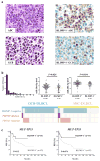Loss of PRDM1/BLIMP-1 function contributes to poor prognosis of activated B-cell-like diffuse large B-cell lymphoma
- PMID: 27568520
- PMCID: PMC5837859
- DOI: 10.1038/leu.2016.243
Loss of PRDM1/BLIMP-1 function contributes to poor prognosis of activated B-cell-like diffuse large B-cell lymphoma
Abstract
PRDM1/BLIMP-1, a master regulator of plasma-cell differentiation, is frequently inactivated in activated B-cell-like (ABC) diffuse large B-cell lymphoma (DLBCL) patients. Little is known about its genetic aberrations and relevant clinical implications. A large series of patients with de novo DLBCL was effectively evaluated for PRDM1/BLIMP-1 deletion, mutation, and protein expression. BLIMP-1 expression was frequently associated with the ABC phenotype and plasmablastic morphologic subtype of DLBCL, yet 63% of the ABC-DLBCL patients were negative for BLIMP-1 protein expression. In these patients, loss of BLIMP-1 was associated with Myc overexpression and decreased expression of p53 pathway molecules. In addition, homozygous PRDM1 deletions and PRDM1 mutations within exons 1 and 2, which encode for domains crucial for transcriptional repression, were found to show a poor prognostic impact in patients with ABC-DLBCL but not in those with germinal center B-cell-like DLBCL (GCB-DLBCL). Gene expression profiling revealed that loss of PRDM1/BLIMP-1 expression correlated with a decreased plasma-cell differentiation signature and upregulation of genes involved in B-cell receptor signaling and tumor-cell proliferation. In conclusion, these results provide novel clinical and biological insight into the tumor-suppressive role of PRDM1/BLIMP-1 in ABC-DLBCL patients and suggest that loss of PRDM1/BLIMP-1 function contributes to the overall poor prognosis of ABC-DLBCL patients.
Conflict of interest statement
The authors declare no conflict of interest.
Figures




Similar articles
-
[Potential mechanism and prognostic value of promoter methylation of PRDM1 gene in diffuse large B cell lymphoma].Zhonghua Bing Li Xue Za Zhi. 2016 Dec 8;45(12):831-837. doi: 10.3760/cma.j.issn.0529-5807.2016.12.004. Zhonghua Bing Li Xue Za Zhi. 2016. PMID: 28056297 Chinese.
-
Epigenetic down-regulation of the tumor suppressor gene PRDM1/Blimp-1 in diffuse large B cell lymphomas: a potential role of the microRNA let-7.Am J Pathol. 2010 Sep;177(3):1470-9. doi: 10.2353/ajpath.2010.091291. Epub 2010 Jul 22. Am J Pathol. 2010. PMID: 20651244 Free PMC article.
-
FOXP2-positive diffuse large B-cell lymphomas exhibit a poor response to R-CHOP therapy and distinct biological signatures.Oncotarget. 2016 Aug 16;7(33):52940-52956. doi: 10.18632/oncotarget.9507. Oncotarget. 2016. PMID: 27224915 Free PMC article.
-
The significance of FOXP1 in diffuse large B-cell lymphoma.Leuk Lymphoma. 2017 May;58(5):1037-1051. doi: 10.1080/10428194.2016.1228932. Epub 2016 Sep 27. Leuk Lymphoma. 2017. PMID: 27678023 Review.
-
Diffuse large B-cell lymphoma.Pathology. 2018 Jan;50(1):74-87. doi: 10.1016/j.pathol.2017.09.006. Epub 2017 Nov 20. Pathology. 2018. PMID: 29167021 Review.
Cited by
-
MiR-223-3p promotes the proliferation, invasion and migration of colon cancer cells by negative regulating PRDM1.Am J Transl Res. 2019 Jul 15;11(7):4516-4523. eCollection 2019. Am J Transl Res. 2019. PMID: 31396355 Free PMC article.
-
Clinical Significance of PTEN Deletion, Mutation, and Loss of PTEN Expression in De Novo Diffuse Large B-Cell Lymphoma.Neoplasia. 2018 Jun;20(6):574-593. doi: 10.1016/j.neo.2018.03.002. Epub 2018 May 4. Neoplasia. 2018. PMID: 29734016 Free PMC article.
-
New agents and regimens for diffuse large B cell lymphoma.J Hematol Oncol. 2020 Dec 14;13(1):175. doi: 10.1186/s13045-020-01011-z. J Hematol Oncol. 2020. PMID: 33317571 Free PMC article. Review.
-
PRDM1 promotes the stemness of gastric cancer cells by enhancing the transactivation of Myc.Transl Oncol. 2025 Sep;59:102443. doi: 10.1016/j.tranon.2025.102443. Epub 2025 Jun 18. Transl Oncol. 2025. PMID: 40532656 Free PMC article.
-
Blimp-1 is a prognostic indicator for progression of cervical intraepithelial neoplasia grade 2.J Cancer Res Clin Oncol. 2022 Aug;148(8):1991-2002. doi: 10.1007/s00432-022-03993-4. Epub 2022 Apr 6. J Cancer Res Clin Oncol. 2022. PMID: 35386001 Free PMC article.
References
-
- DeVita VT, Jr, Canellos GP, Chabner B, Schein P, Hubbard SP, Young RC. Advanced diffuse histiocytic lymphoma, a potentially curable disease. Lancet. 1975;1(7901):248–250. - PubMed
-
- Coiffier B, Lepage E, Briere J, Herbrecht R, Tilly H, Bouabdallah R, et al. CHOP chemotherapy plus rituximab compared with CHOP alone in elderly patients with diffuse large-B-cell lymphoma. N Engl J Med. 2002;346(4):235–242. - PubMed
-
- Coiffier B, Thieblemont C, Van Den Neste E, Lepeu G, Plantier I, Castaigne S, et al. Long-term outcome of patients in the LNH-98. 5 trial, the first randomized study comparing rituximab-CHOP to standard CHOP chemotherapy in DLBCL patients: a study by the Groupe d’Etudes des Lymphomes de l’Adulte. Blood. 2010;116(12):2040–2045. - PMC - PubMed
-
- Friedberg JW. Relapsed/refractory diffuse large B-cell lymphoma. Hematology Am Soc Hematol Educ Program. 2011;2011:498–505. - PubMed
Publication types
MeSH terms
Substances
Grants and funding
LinkOut - more resources
Full Text Sources
Other Literature Sources
Molecular Biology Databases
Research Materials
Miscellaneous

